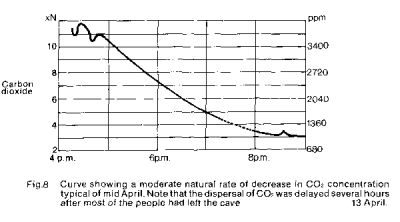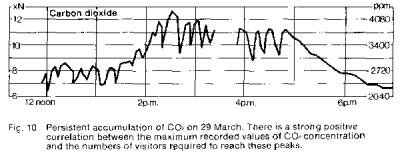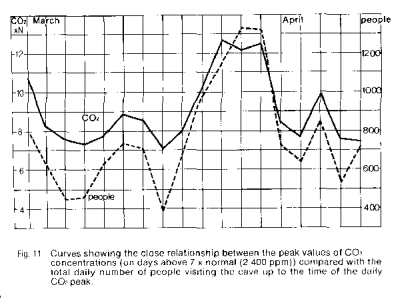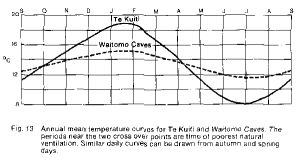CAVE CORROSION BY TOURISTS
INTRODUCTION
In Waitomo Caves some of the calcite speleothems have developed a very porous surface texture quite different from anything known in other caves not visited by large parties of tourists. Dr. W.A. Watters, Chief Petrologist, New Zealand Geological Survey has made an examination and reported (pers. comm.) that the main surface feature of these stalactites was due to corrosion, though this appeared to be modified by local deposition of very fine-grained calcite (not aragonite) which could be due to fluctuations in partial pressure of carbon dioxide (CO2). The stalactites were hanging in the main flow path of a warm, humid, carbon dioxide-rich air. Similar effects have been reported by M. Sheard (pers. comm.) from tourist caves at Tantanoola, South Australia.
Also in Waitomo caves small areas of horizontal ceiling rock immediately above the tourist path show a honeycomb pitting of the limestone surface where drops of water had gathered. Investigations suggested that this water had been derived by the condensation of the humid cave air, and also the exhaled breath of tourists, rather than from seepage water, and that the pendant drops had absorbed some of the excess CO2 that had often accumulated in that chamber. The resultant weak acid had been sufficient to corrode the limestone ceiling, and the release of CO2 had caused local redeposition around each small rim of the honeycomb surface.
Carbon dioxide derived from the soil and atmosphere is the prime agent in the dissolution of limestone, and therefore in the origin and development of caves. Russell (1973) quoted normal soil CO2 concentrations as being 1700 to 7400 parts per million (ppm), but gives extremes of 100 and 130,000ppm. The deposition or dissolution of calcite in a cave is dependent on the delicate balance between the CO2 in the cave air and the CO2 dissolved in the percolation water (Roques 1969). The forest and its ground litter produce organic CO2 which dissolves to form acidic soil water. At depth this acid is available to dissolve the limestone and the percolating ground water becomes saturated with carbonate. The dissipation of hydrostatic pressure as the carbonate saturated percolation water enters the cave atmosphere causes the release of gaseous CO2 and calcite is deposited.
These reactions can be expressed by the simple reversible chemical equation:
H2O + CO2 + CaCO3 ⇔Ca(HCO3)2 ⇔CaCO3 + CO2 +H2O
soil water + soil air + limestone⇔percolation solute⇔calcite + cave air + water
A cave decorated with calcite must have an atmosphere with a CO2 concentration of less than 2400ppm if the water that percolates through and over the speleothems is to continue to precipitate calcium carbonate. Whenever the CO2 concentration rises above 2400ppm the water becomes corrosive by absorbing CO2 and thus is able to dissolve calcite.
The earth's atmosphere contains about 340ppm of CO2. Representative concentrations typical of the underground atmosphere of pristine caves were studied in Ruakuri Cave where the measured CO2 concentration ranged from 170 to 850ppm. Similar results were obtained from an upper gallery in Waitomo Caves, where on four consecutive days in May, when the cave was temporarily closed and only 130 people entered on the third day, the CO2 concentrations ranged from 500 to 600ppm. During the 23 days of continuous recording the CO2 was less than free atmosphere for 13% of the time, but because Waitomo Caves are so popular with tourists it has been impossible to determine the natural maximum value for CO2. Delecour, Weissen and Ek (1968) suggested from their research in Belgium that in most cave atmospheres the CO2 concentrations were typically between 600 and 1900ppm, but extremes ranged from 340 to 6500ppm.
People exhale air that is slightly depleted in oxygen and enriched in CO2 in a proportion that is fairly constant at about 40,000ppm, but the total amount of CO2 exhaled depends on the rate of breathing. This rate is about 1800 litres per hour for people walking, standing or climbing a few stairs, and therefore each cave visitor exhales about 1.2 litres per minute of warm CO2. In the cave CO2 is mixed and diluted by convection, but it can accumulate, and become concentrated enough to cause stress to visitors.
In Belgium, CO2 concentrations of 3700ppm were recorded at l.6m above the cave floor, after some 450 people had visited Remouchamps Cave on a busy summer day (Merenne-Schoumaker, 1975). In Waitomo a maximum of 4200ppm was recorded 0.9m above the cave floor on a busy autumn day after 1170 people had passed by, and tourist-derived concentrations greater than 5000 ppm have been recorded (Hendy & McCabe, 1977).
In order to assess the rates of change in CO2 concentrations in a simple cave environment the recordings made in an upper level cul-de-sac of Waitomo Caves during autumn 1975 have been used (Figure 7). On 18 days CO2 concentrations were greater than 2400ppm, that is, greater than 7 times normal atmosphere and capable of corroding the calcite.
INCREASE IN CO2
The overall average increase from the 18 days records was equal to about 4.3ppm per person. The most rapid increase was on 31 March at 4.00pm when 50 persons caused the CO2 concentration to increase by 1190ppm (i.e. 23.8ppm per person). The reasons for these variations in the rates of increase are not apparent from the records available but natural ventilation or ventilation induced by the movement of people are the most likely causes. Similar rapid increases were recorded at sites in open passages and in other caves.

Figure 7: Curve showing the rapid increases in CO2 concentration on 31 March at 4pm after a party of 50 people had entered the chamber.
DECREASE IN CO2
The maximum natural rate of decrease in CO2 concentration of about 5.7% for each 10 minutes was recorded several times (e.g. 31 March) (Figure 8). During mid-April a lesser natural rate of decrease was common (Figure 9), and the dispersal of CO2 was delayed several hours and continued after most of the people had left the cave.

Figure 8: Curve showing a moderate natural rate of decrease in CO2 concentration typical of mid April.

Figure 9: Curve showing a moderate natural rate of decrease in CO2 concentration typical of mid April
ACCUMULATION OF CO2
On 29 March, the CO2 concentration remained above 2400ppm for 6 hours during which time 960 people entered the chamber (Figure 10). There is a very strong positive correlation between the maximum recorded CO2 concentrations and the number of visitors required to reach these peaks. The hourly pattern of the number of visitors changes as the daily total of visitors increases, and on the busiest days the elimination of the lunch break was the major factor in causing corrosive concentrations of CO2 during the afternoons (Figures 11, 12).

Fig 10 Persistent accumulation of CO2 on 29th March.

Fig 11 Curves showing the close relationship between peak values of CO2.

Fig 12 Smoothed Curves showing the patterns of total visitor numbers
VENTILATION OF CAVES
Short or small caves ventilate by the exchange of cave air with outside air in response to the constantly changing density of the outside atmosphere. The main variables that can alter the density of the atmosphere are temperature, pressure and humidity. Deep within Waitomo Caves the differences in relative humidity generally range between 85 and 100% and thus produce a variation in air density of less than 0.2%. Barometric pressure is the same inside and outside the cave and ranges from 980 to 1040 mb the extremes of which would only account for changes in air density of less than 6.2%. Temperatures inside the cave range from 8.0 to 25.0°C and account for changes in air density of 7.6%. This includes changes of 3.6% that could be directly attributed to people or lights. When however the outside extremes of -3.0 to +30.5°C are considered the changes in air density caused by temperature changes would be the greatest driving force in the natural ventilation of the cave.
All three variables interact to produce maximum density during intense anti-cyclones with cold, dry air and calm conditions, and minimum density during deep depressions with hot, humid air and strong winds.
Waitomo Caves has two entrances, one higher than the other, from one or other of which a fairly persistent gentle breeze often issues. In cool or cold conditions the cave functions in the same way as a chimney. Cold air is drawn into the lower entrance, is warmed inside the cave and rises to emerge from the upper entrance. In warm or hot conditions the air movement is reversed, because the cave is cooler than the outside air, and the air flows out through the lower entrance while warm air is being drawn in at the upper entrance. When the outside mean temperature is about equal to the cave mean temperature (April and October) then the natural ventilation is at its least effective (Figure 13). Rising morning temperatures assist good natural ventilation.

Figure 13: Annual mean temperature curves
CONCLUSIONS
The management of a cave renowned for its calcite speleothems should restrict the visitors to a number that will keep maximum CO2 concentrations of the cave air below 2400ppm, and, if sparkling, crystalline, calcite growth is to be maintained, then average CO2 concentrations should be very much lower than that maximum value, without altering the natural system of temperature, humidity and pressure of the cave atmosphere.
REFERENCES
DELECOUR, F., WEISSEN, F., and EK, C. 1968. An electrolytic field device for the titration of CO2 in air. National Speleological Society Bulletin 30(4). 131-6
HENDY, C., and McCABE, B. 1977. Geochemical Research on the Cave Atmosphere. Unpublished Report. Waitomo Day Seminar 1977.
KERMODE, L.O. 1974 (a). Glow-worm Cave, Waitomo - Conservation Study. New Zealand Speleological Bulletin 5(91). 329-44.
KERMODE, L.O. 1977. Some Aspects of the Influence of Tourists on the Microclimate of Waitomo Cave. New Zealand Geological Survey, unpublished Report G14.
KERMODE, L.O. 1978. Cave Visitors and Calcite Corrosion - Excess Carbon Dioxide in Waitomo Caves. Unpublished Report to Waitomo Caves Scientific Research Programme. New Zealand Geological Survey, D.S.I.R., Otara.
MERENNE-SCHOUMAKER, B. 1975. Aspects de l'influence des touristes sur les microclimate de la grotte de Remouchamps. Annales de Speleologie 39(2). 273-85.
ROQUES, H. 1969. A Review of present day problems in the physical chemistry of carbonates in solution. Transactions of the Cave Research Group of Great Britain 11(3). 139-63.
RUSSELL, E.W. 1973. "Soil Conditions and Plant Growth". Longman, London.